True Parmigiano draws its flavour not only from the way it is aged but from the rich pastures specific to parts of the Po valley. The cows must only eat grass and hay from the zona tipica – strictly controlled region that encompasses the provinces of Reggia Emilia and Modena, part of Bologna and the part of Mantua that lies south of the Po River.
Each wheel is stamped with its origins, date it was made and the stamp of the Consortium of Parmigiano Reggiano which controls the way the fodder is grown, what it is fed, the way milk is collected and even the time of day cheese has been made.
While many parmigiano reggiano cheese makers buy milk from local producers, Auricchio make their wheels only with milk of the family's prize cows. The cows eat organic hay and drink only mineral water this way the Auricchio family have greater control over the final quality of the cheese. The colour of the curd is most important, if the cows eat grass the milk becomes yellow if they eat hay the curd is white and Auricchio prefer to have white coloured curd.
 |
Skimmed unpastuerised milk is poured into copper cauldrons. Having rested for an hour it separates naturally from the cream which remains behind. |
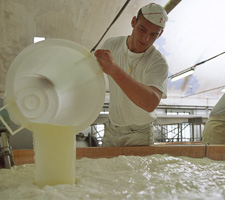 |
A natural whey starter is added to the milk (made from the left over whey of the previous days batch of cheese left overnight in a sealed container to ferment), this contains natural enzymes that are critical to the final flavour. |
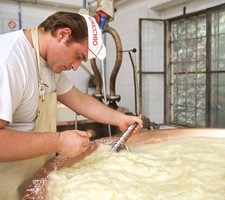 |
Steam is then pumped into a maze of tubes that line the copper cauldron while the milk is kept swirling. Then once it has reached a certain temperature of 33 C and 35 C veal rennet is added and the milk is stirred for a final two minutes before the heat is turned off. This moment is critical... the cheesemaker hovers anxiously over the vat testing the texture of the curd until the magic moment when it separates from the whey. The curds are broken into corn like particles before the final cheese mass is cut in two. |
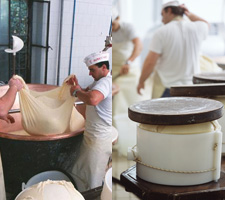 |
Each portion is hoisted by cheese cloth into plastic moulds. From now on the cheese must be turned at precise intervals around the clock including 2am. |
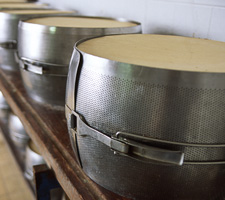 |
The wheels are then placed in metal moulds and two days later in salt baths for 25 days. Once again frequent turning is critical throughout this infusion and long after when in warehouses where it stays for 2–3 years often turned by hand |
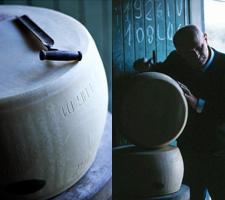 |
A little hammer enables Auricchio to listen to the heart of the cheese and detect any faults during the lengthy aging process. Parmigiano Reggiano is an exacting taskmaster – one that requires round the clock devotion, the love of the cheese maker and the human heart not just the hand of a machine. |


